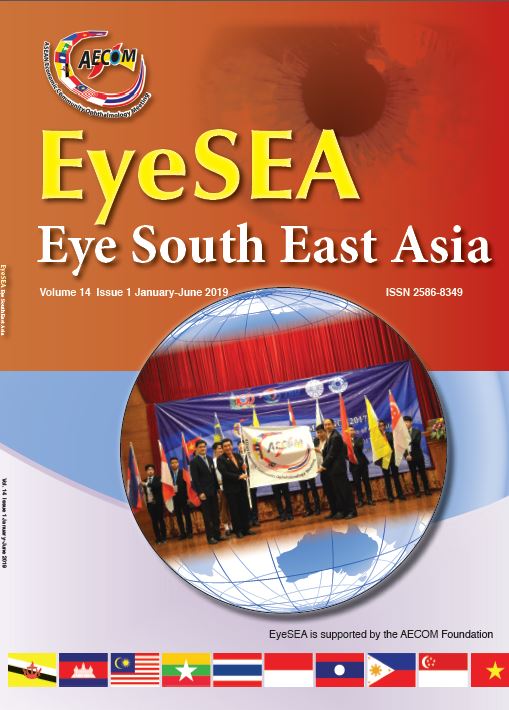Infective keratitis in advanced glaucoma patients
Main Article Content
Abstract
Background: To describe a case series of infective keratitis in patients with advanced glaucoma in Selayang Hospital, Malaysia.
Methods: This is a descriptive, retrospective case series. Data from January 2013 to December 2017 was traced from hospital database and analyzed.
Results: A total of 17 eyes of 16 patients was included in this series. Seven were males and nine were females. Mean age group was 64 ± 12 years old (range 48 to 93 years old). Twelve patients had underlying diabetes mellitus. Seven patients (44%) had primary glaucoma (Six POAGs and one PACG), while nine patients (56%) had secondary glaucoma, of which six were due to rubeosis iridis. All patients had premorbid vision of counting fingers or worse. Thirteen patients (81%) were on long term topical anti-glaucoma treatment prior to the development of infective keratitis. Most of the patients had poor IOP control at the time of diagnosis. Painful red eyes were the main presenting symptoms. Corneal scrapings were positive in nine (64.3%) out of the fourteen cases, in which three were Pseudomonas aeruginosa, one Klebsiella sp., three Streptococcus sp., and three others had mixed growth. Majority of the cases were treated medically, but three eyes required evisceration.
Conclusion: Diabetes mellitus, uncontrolled IOP, long term topical anti-glaucoma drops and poor premorbid vision are risk factors for developing infective keratitis in advanced glaucoma patients. Infective keratitis can lead to significant morbidity in this group of patients whose quality of life is already poor.
Conflicts of interest: The authors report no conflicts of interest.
Acknowledgment: We would like to thank the Director General of Health Malaysia for his permission to publish this article.
Article Details
References
2.Shah A, Sachdev A, Coggon D, Hossain P. Geographic variations in microbial keratitis: An analysis of the peer-reviewed literature. Br J Ophthalmol 2011;95(6):762–7.
3.Bikbova G, Oshitari T, Tawada A, Yamamoto S. Corneal changes in diabetes mellitus. Curr Diabetes Rev
2012;8(4):294-302.
4.Teuchner B, Wagner J, Bechrakis NE, Orth-Höller D, Nagl M. Microbial contamination of glaucoma eyedrops used by
patients compared with ocular medications used in the hospital. Medicine 2015;94(8)
583.
5.Naito T, Namiguchi K, Yoshikawa K, Miyamoto K, Mizoue S, Kawashima Y, Shiraishi A, Shiraga F. Factors affecting eye drop instillation in glaucoma patients with visual field defect. PloS one. 2017;12(10):e0185874.
6.Terai N, Müller-Holz M, Spoerl E, Pillunat LE. Short-term effect of topical antiglaucoma medication on tear-film stability, tear secretion, and corneal sensitivity in healthy subjects. Clin Ophthalmology
2011;5:517-25.
7.Baratz KH, Nau CB, Winter EJ, McLaren JW, Hodge DO, Herman DC, Bourne WM. Effects of glaucoma medications on corneal endothelium, keratocytes, and subbasal nerves among participants in the ocular hypertension treatment study. Cornea. 2006;25(9):1046-52.
8.Martin KR, Broadway DC. Cyclodiode laser therapy for painful, blind glaucomatous eyes. Br J Ophthalmol.
2001;85(4):474-6.
9.McDonald EM, Ram FS, Patel DV, McGhee CN. Topical antibiotics for the management of bacterial keratitis: an evidence-based review of high quality randomised controlled trials. Br J Ophthalmol. 2014;98(11):1470-7.


